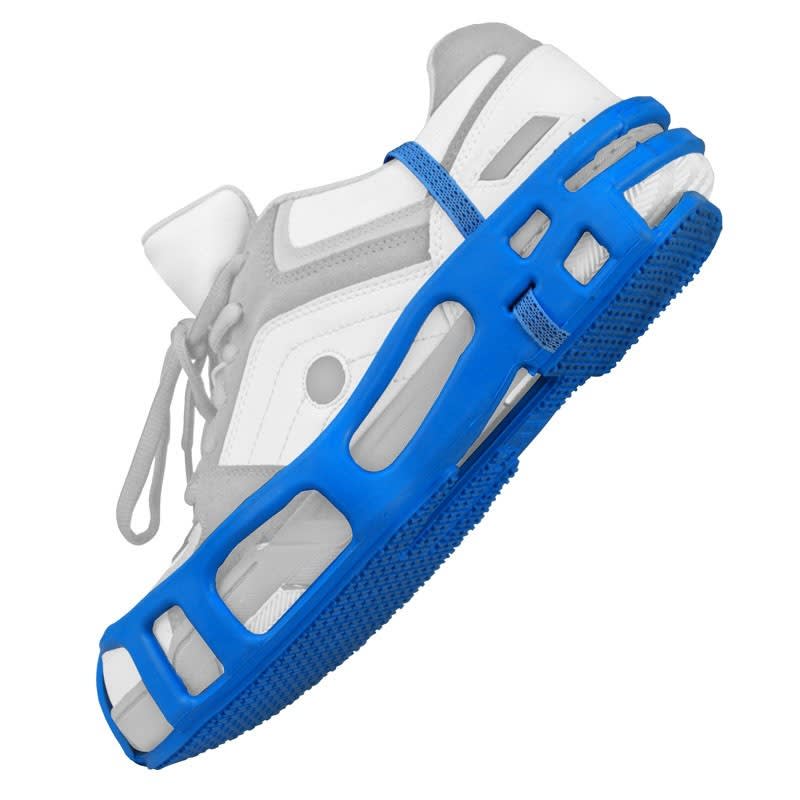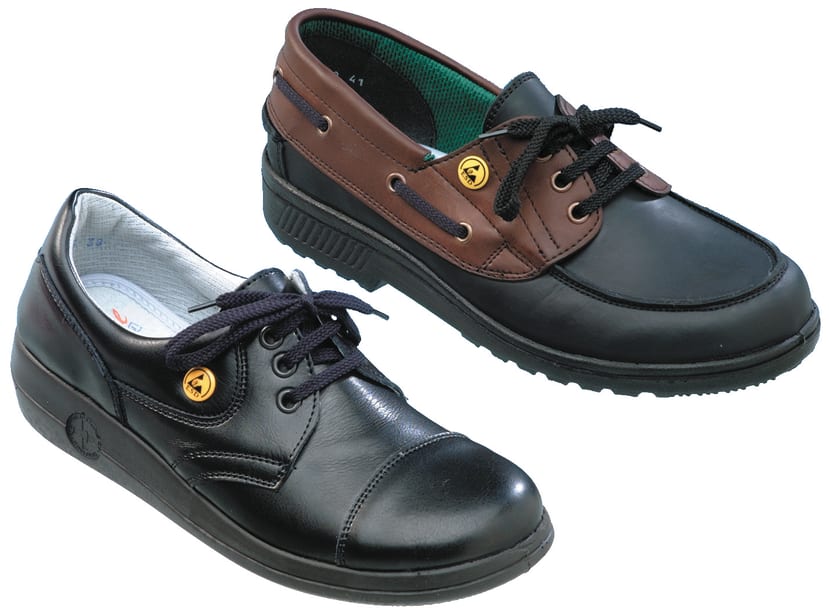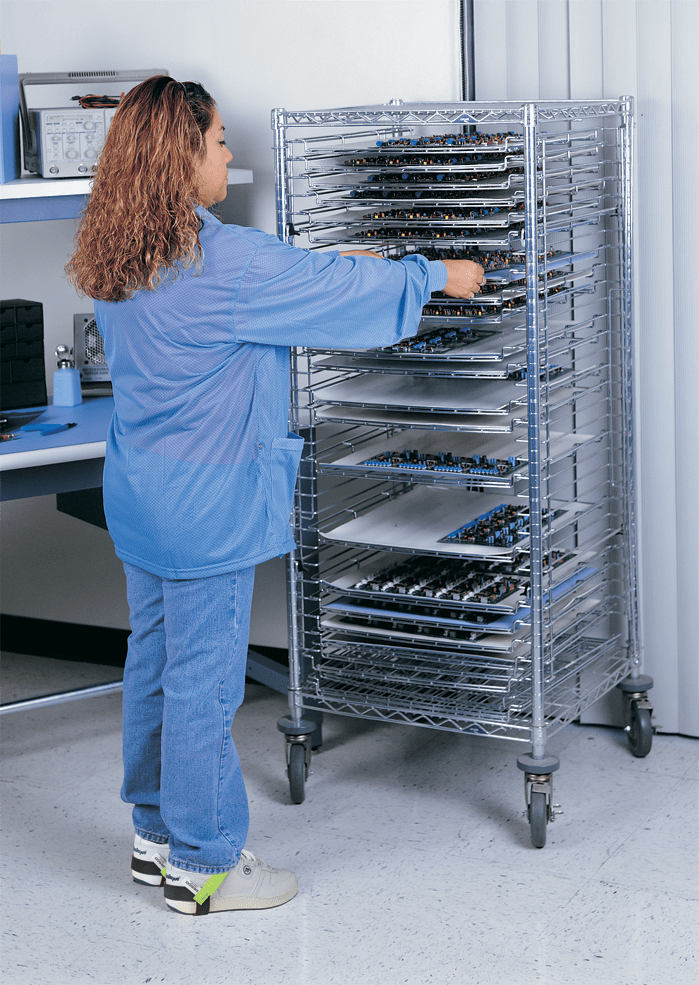ESD Foot Grounders or ESD Shoes – what’s best?
Follow articleHow do you feel about this article? Help us to provide better content for you.
Thank you! Your feedback has been received.
There was a problem submitting your feedback, please try again later.
What do you think of this article?
We get a lot of customers asking us if they should use ESD foot grounders or ESD shoes in their EPA. And our answer is always the same: it depends! There really is no right or wrong when it comes to choosing but there are obviously a few things you need to consider before investing in one or the other.
Safety First!
In some cases, protective footwear (shoes, boots, etc.) is required to prevent foot injuries due to falling or rolling objects or from objects piercing the sole. Safety of the operator takes priority over ESD control at all times. If protective footwear with reliable ESD properties is not available or ESD foot grounders cannot be worn with the protective footwear in the ESD Protected Area, other personnel grounding devices such as wrist straps should be used.
Introduction to ESD Foot Grounders
ESD foot grounders are designed to reliably contact grounded ESD flooring and provide a continuous path-to-ground by removing electrostatic charges from personnel. They are easy to install and can be used on standard shoes by placing the grounding tab in the shoe under the foot.
Example of ESD Foot Grounder
Guidelines for ESD foot grounders:
- It is recommended that ESD foot grounders are worn on both feet in order to ensure that a continuous path to ground is maintained at all times (even when lifting one foot).
- Contact strips should be tucked inside the shoe with as much contact area as possible to the bottom of the stockinged foot. ESD foot grounders rely upon the perspiration layer inside of the shoe to make contact through the stocking.
- A current limiting one or two megohm resistor in series with the contact strip is recommended but not required.
- ESD foot grounders should be tested independently at least daily while being worn.
Advantages of ESD Foot Grounders
ESD foot grounders are often preferred over shoes because one size fits many foot sizes, thereby reducing stock holdings and simplifying operations. ESD foot grounders also usually pass the mandatory resistance test as soon as worn, whereas some ESD shoes require a ‘warm-up period’ in order for the operator’s RG to drop below 35 megohms. They are easily replaceable, quick to put on and less bulky than ESD shoes. They can also be easily taken off when leaving an EPA.
Disadvantages of ESD Foot Grounders
A common complaint with ESD foot grounders is that they don’t last very long. However, there are a few simple tricks to avoid a quick ‘burn-out’:
- The useful life of an ESD foot grounder will depend a lot on the floor and its surface roughness: the rougher the floor the greater the wear. We recommend ESD foot grounders only to be used indoors where floors are usually smoother (and where the ESD foot grounder is less likely to become wet, thereby short circuiting the resistor).
- The manner in which the wearer walks can also affect the life span of the grounder.
In summary, with reasonable care and if used only indoors, ESD heel and toe grounders can last several weeks.
Introduction to ESD Shoes
Conductive additives are blended into the sole (inside to outside) of ESD shoes and connect to the operator’s feet. ESD shoes provide an electrically conductive path from the wearer to the floor - from the operator’s socks (through the sweat layer), to the insole and then to the other outer sole.
Examples of ESD Shoes
There are a number of considerations when selecting ESD shoes:
- Does the ESD shoe meet the ESD Association (ESDA) standards? Many manufactures of ESD shoes often reference ASTM standards for their ESD specification but state nothing about ESDA standards. The ESDA standards are written specifically for electronics manufacturing and handling. The walking test defined in the ANSI/ESD STM97.2-2006 is one of the most important methods for qualifying ESD shoes for use in ESD Protected Areas.
- Not all ESD shoes is created equal. There are different styles of ESD shoes. In most cases the specifications of each style will vary. While one style of ESD shoes may retain its ESD properties for 6 months or longer, another will start failing within 90 days. The performance of all styles of ESD shoes should be verified at least daily on an on-going basis and records should be kept for quality control purposes.
Advantages of ESD Shoes
The major advantage of ESD shoes is that they do not require a tab to connect to the operator. There won’t be any issues with the tab not staying inside the shoe – as soon as ESD shoes are put on, the operator is grounded. ESD shoes are unlikely to be put on incorrectly and have a lower chance of breaking compared to ESD foot grounders. They are generally more reliable and durable.
Disadvantages of ESD Shoes
A big drawback with ESD shoes is obviously the larger initial investment cost. Especially, if you have a large number of operators working in your EPA, it will be costlier to equip everyone with ESD shoes.
Final Thoughts
Now you know all the ins-and-outs of ESD foot grounders and ESD shoes, you’re probably more confused than ever. So what should you go for? Well, as we said right at the beginning of this post: it depends! It depends, e.g.
- On your budget: are you prepared to initially invest a larger amount of money or would you prefer to spread the costs evenly over time? Also consider the cost over a longer period of time (i.e. 2 or 5 years). Whilst ESD shoes are more expensive initially, ESD foot grounders have to be replaced regularly which adds up, as well.
- On your operators: When selecting your ESD grounding device, it is a good idea to consider the opinion of the operators. They may not find the style of ESD shoe being considered to be comfortable or they may become frustrated that the ESD foot grounder that has been selected does not stay secured properly. In some facilities, many operators are temporary or on a flexible schedule that would not justify certain types of ESD footwear and it is never recommended that operators share footwear due to hygiene issues.
ESD Heel Grounders in Use
So have a hard look at the numbers and an honest conversation with your employees and then take it from there!




